You'll encounter the keukegen in Japan's most forsaken spaces—a diminutive yōkai shrouded in matted, pestilent hair that harbors lice, fleas, and mites. First codified by Toriyama Sekien in his 1776 *Gazu Hyakki Yagyō*, this eldritch creature manifests where neglect festers, bringing typhus, plague, and exhaustion to those dwelling amid decay. Edo-period communities understood what modern science confirms: filth breeds affliction, whether spiritual or biological. Traditional purification through sweeping, salt barriers, and incense fumigation banished this tangible manifestation of contamination's consequences. The ancient wisdom encoded within this creature's legend reveals far more than superstition alone suggests.
🔮 Enhance Your Practice With These Essentials
Chosen for ritual alignment and energetic correspondence.
🔮 Enhance Your Practice With These Essentials
Chosen for ritual alignment and energetic correspondence.
🎯 Recommended Products
Handpicked items related to this article:
As an Amazon Associate, we earn from qualifying purchases.
🔮 Enhance Your Practice With These Essentials
Chosen for ritual alignment and energetic correspondence.
🔮 Enhance Your Practice With These Essentials
Chosen for ritual alignment and energetic correspondence.
🔮 Enhance Your Practice With These Essentials
Chosen for ritual alignment and energetic correspondence.
Key Takeaways
- The Keukegen is a small, dog-sized yokai covered in matted, filthy hair that conceals its features and emits decay odor.
- It inhabits neglected spaces like abandoned buildings and unsanitary homes, thriving in environments characterized by filth and poor sanitation.
- The creature harbors disease vectors including lice, fleas, and mites, linked to illnesses like typhus, plague, and scabies.
- First documented in 1776 by Toriyama Sekien, it symbolized Edo-era anxieties about urban overcrowding and contamination.
- Traditional removal methods include rigorous cleaning, salt purification, and incense fumigation, reflecting hygiene practices embedded in spiritual beliefs.
The Physical Appearance of the Keukegen
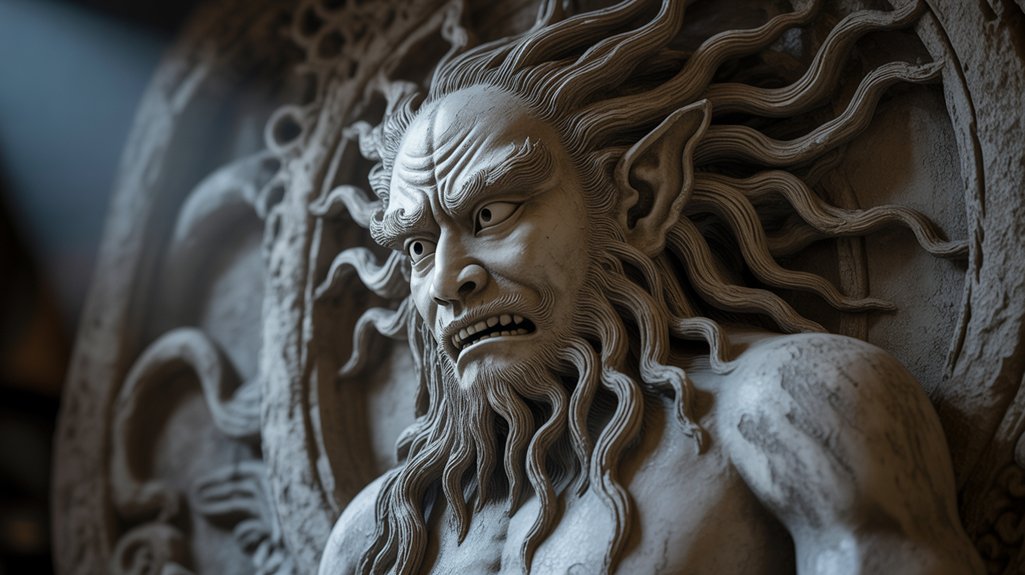
Though the Keukegen defies easy categorization within Japan's vast yōkai taxonomy, its corporeal manifestation has remained remarkably consistent across centuries of folklore documentation.
You'll find this entity described as a diminutive creature, scarcely larger than a small dog, its entire form obscured beneath cascading layers of matted, filthy hair. The physical traits suggest something chimeric—neither wholly animal nor spirit, existing in that liminal space between tangible and eldritch.
The hair characteristics define its essence entirely. Black, gray, or yellowed strands shroud whatever anatomy lies beneath, creating an ambulatory mass of pestilence-bearing fur.
Matted filth conceals all form—black, gray, yellowed strands transform the Keukegen into living pestilence shrouded in corrupted hair.
You can't discern eyes, limbs, or features through this impenetrable veil. Ancient texts describe the hair as perpetually damp, reeking of decay and harboring countless disease vectors within its tangled depths.
This ambulatory tangle moves with unsettling purpose through neglected spaces, embodying the accumulated filth of human negligence made manifest.
Origins and First Recorded Accounts
You'll find the keukegen's earliest textual manifestation in the *Ehon Hyaku Monogatari* (Picture Book of a Hundred Stories), compiled during the Edo period around 1841, where the creature emerges from the brushstrokes of an unknown artist who understood the eldritch relationship between domestic squalor and supernatural pestilence.
The documentation proliferated through subsequent Edo-era *yōkai* encyclopedias—those chimeric catalogs of the uncanny—each iteration adding layers of regional variation as the myth migrated from urban centers to provincial households.
What began as a singular folkloric warning evolved across centuries into a pan-Japanese archetype, its evolution traceable through woodblock prints, medical treatises conflating spiritual with physical illness, and oral traditions that still whisper of hair-like apparitions in neglected spaces.
Ancient Folklore Text References
| Text Source | Publication Date | Keukegen Description |
|---|---|---|
| *Gazu Hyakki Yagyō* | 1776 | Hair-covered disease spirit |
| *Konjaku Gazu Zoku Hyakki* | 1779 | Dwelling in unclean spaces |
| *Hyakki Tsurezure Bukuro* | 1781 | Causes mysterious ailments |
Ancient texts rarely mention keukegen directly; rather, they reference nameless filth-spirits haunting forgotten corners. Sekien's codification altered these scattered references into definitive yōkai taxonomy, granting freedom to understanding Japan's supernatural hierarchies.
Edo Period Documentation
During the cultural efflorescence of the Edo period (1603-1868), when urban centers swelled beyond sanitary infrastructure and disease festered in overcrowded nagaya tenements, artists and scholars began systematically cataloging supernatural entities that had previously existed only in oral tradition.
You'll find keukegen documented in Toriyama Sekien's influential *Gazu Hyakki Yagyō* (1776), depicted as diminutive, hirsute creatures haunting neglected spaces.
Edo hygiene—or its catastrophic absence—birthed these eldritch manifestations. Filth beliefs intertwined with medical understanding; physicians couldn't distinguish spiritual corruption from bacterial infection.
The keukegen emerged where darkness pooled thick. Where waste accumulated. Where bodies pressed together in airless quarters, breeding pestilence.
These chimeric entities embodied collective anxiety about contamination, their very existence a warning etched in ink and woodblock.
Regional Myth Evolution
Before Toriyama Sekien immortalized these entities in woodblock prints, keukegen legends percolated through Japan's provincial villages with striking regional variation—each iteration shaped by local environmental pressures and endemic disease patterns.
Coastal settlements emphasized the creature's affinity for damp tatami mats, while mountainous regions portrayed it as an eldritch manifestation of winter ailments. These myth adaptations reflected immediate health concerns: Hokkaido variants linked the spirit to frostbite-induced lethargy, whereas Kyushu iterations connected it to humid, subtropical maladies.
You'll discover chimeric alterations across prefecture boundaries. Regional variations altered the keukegen from dog-like to insectoid, each morphology expressing local anxieties about contagion.
The spirit embodied vernacular medical knowledge—a living taxonomy of illness before germ theory penetrated Japan's isolated communities.
Habitat and Preferred Dwelling Places
Where shadows accumulate and cleanliness fails, the keukegen thrives in environments that embody neglect and decay. You'll find this eldritch creature lurking where civilization's maintenance falters—within traditional homes harboring forgotten corners, abandoned buildings surrendering to entropy, and damp basements breathing mold. Urban environments offer particular sanctuary: overcrowded spaces where sanitation crumbles beneath population pressure. Rural settings aren't exempt; neglected farmhouses become chimeric breeding grounds.
| Environment Type | Specific Locations | Seasonal Peak |
|---|---|---|
| Urban Dwellings | Hidden corners, cluttered apartments | Year-round |
| Rural Structures | Abandoned granaries, decaying barns | Summer humidity |
| Traditional Homes | Beneath floorboards, attic recesses | Rainy season |
Cultural preferences reveal patterns: the keukegen gravitates toward spaces embodying *kegare*—spiritual pollution through physical filth. Seasonal changes amplify infestations; humidity intensifies presence. You won't escape by location alone. The creature follows human negligence wherever it manifests, adapting across centuries while maintaining territorial claims over squalor's domain.
The Connection Between Filth and Disease
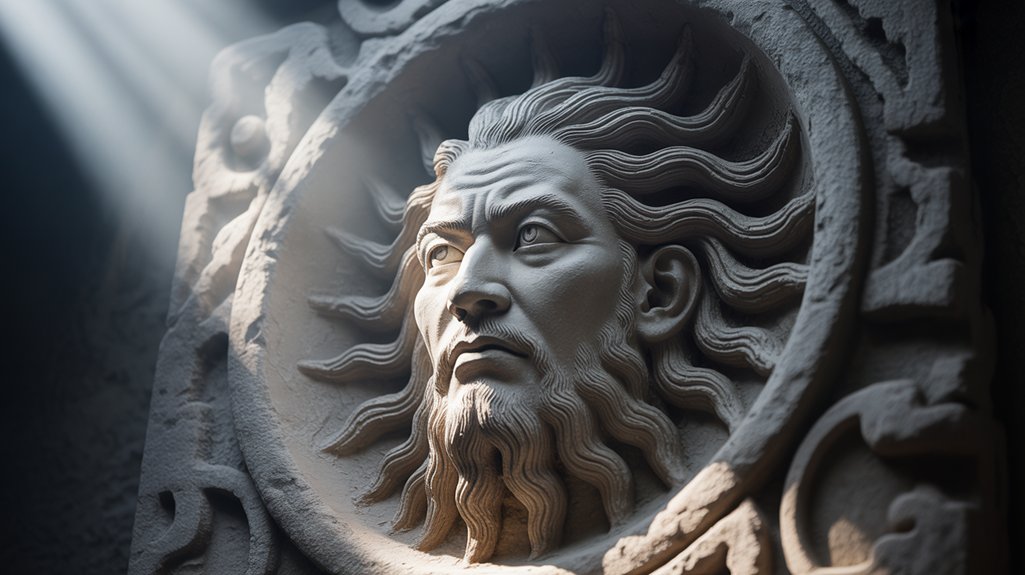
You'll find that the keukegen embodies centuries of accumulated Japanese wisdom regarding the intrinsic relationship between environmental degradation and corporeal affliction, a chimeric synthesis where spiritual malevolence manifests through tangible vectors of contamination.
Pre-Meiji era physicians, lacking germ theory's framework, attributed mysterious ailments—particularly the persistent itching and weakness associated with parasitic infestations—to yokai born from filth's eldritch miasma, nesting in dust-laden corners where sunlight couldn't penetrate.
The creature's very form, composed of matted hair harboring vermin, alters abstract hygiene principles into visceral spiritual architecture, making disease's invisible mechanisms terrifyingly, unforgettably visible.
Historical Views on Hygiene
During Japan's medieval period—spanning the Kamakura era (1185-1333) through the turbulent Sengoku age (1467-1615)—physicians and monks recognized an undeniable correlation between accumulated grime and the manifestation of bodily afflictions, though they understood this connection through supernatural rather than microbial frameworks.
Historical hygiene practices became intertwined with spiritual purification rituals, as Buddhist monasteries established bathing protocols that served both corporeal and metaphysical purposes.
You'll find that cultural cleanliness beliefs positioned dirt as a conduit for eldritch entities like the keukegen, whose chimeric form—neither wholly beast nor spirit—emerged from refuse-strewn dwellings.
These practitioners didn't perceive bacteria. Instead, they witnessed malevolent essences coalescing within filth's shadows.
Disease wasn't infection. It was possession.
Parasites in Unclean Environments
The keukegen's legendary association with filth possessed an uncomfortable verity that medieval observers couldn't articulate through their spiritual taxonomies—unsanitary conditions genuinely bred corporeal harm, though the vectors weren't spectral manifestations but parasitic organisms thriving within accumulated refuse.
You'll find disease transmission flourished wherever hygiene collapsed: lice, fleas, mites colonizing unwashed bodies and contaminated dwellings. The eldritch creature symbolized tangible threats—typhus from body lice, plague from rat fleas, scabies from burrowing mites.
Medieval Japanese communities, lacking microscopic vision, attributed these afflictions to yokai intervention. They weren't entirely wrong. The keukegen represented chimeric understanding: spiritual warning mapped onto biological reality.
Clean environments disrupted parasitic lifecycles, severing disease transmission pathways. Ancient wisdom encoded empirical observation within supernatural narrative, protecting communities through fear of supernatural consequence.
Spiritual Manifestations of Sickness
Where biological contamination festered, medieval Japanese consciousness perceived spiritual corruption—not metaphor, but phenomenological reality experienced through their cosmological framework.
The keukegen embodied this eldritch intersection where spiritual health collapsed alongside physical wellness, manifesting disease symbolism through its chimeric, hair-covered form.
You'll find this yokai demonstrated four essential principles:
- Miasmatic corruption altered stagnant spaces into portals for supernatural affliction
- Corporeal manifestation of illness preceded visible symptoms—the spirit arrived first
- Environmental degradation invited parasitic entities that fed on negligence
- Psychosomatic reality merged observable sickness with invisible forces
Medieval physicians recognized these weren't separate phenomena.
Filth attracted keukegen; keukegen generated pestilence. This reciprocal relationship demanded vigilance against both material decay and spiritual intrusion—simultaneous purification of dwelling and soul.
How the Keukegen Causes Illness
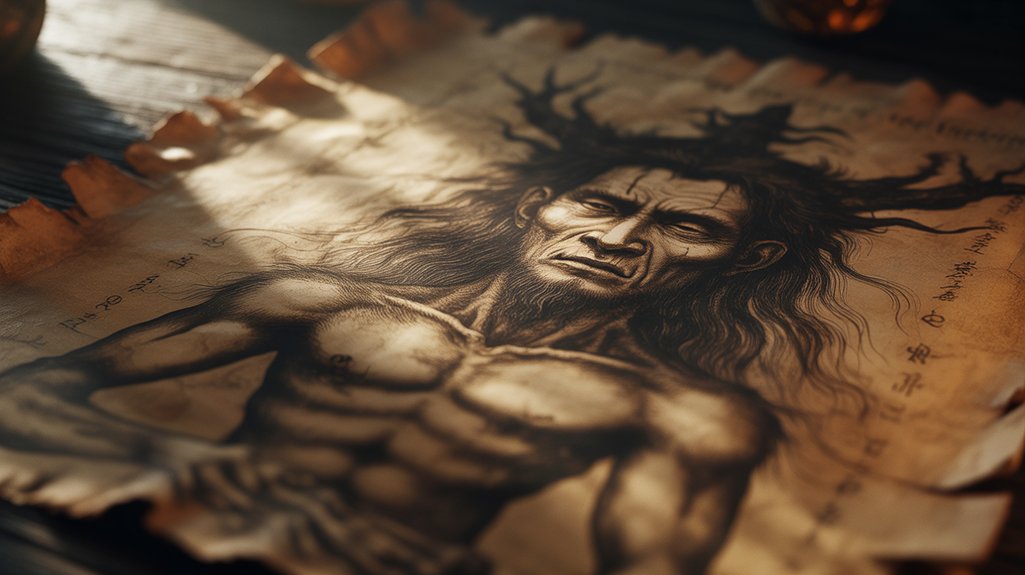
According to ancient Japanese belief systems, keukegen inflict their particular brand of malaise through sustained proximity to accumulated filth and stagnation—their very existence tied to the miasmic corruption that festers in neglected spaces.
You'll find the mechanism of spiritual disease operates through environmental degradation itself becoming animate, conscious, malevolent. The creature doesn't simply inhabit squalor; it embodies it.
Keukegen symbolism reveals a profound understanding of contagion's invisible pathways. These eldritch manifestations attach themselves to homes left unswept, corners thick with dust, rafters wrapped in cobwebs—transforming negligence into pathology.
Their tiny, hair-covered forms creep across floorboards at night, exhaling pestilence with each movement.
The resulting afflictions manifest as exhaustion, fever, weakness. Persistent malaise. Your body mirrors the environment's decay, demonstrating how physical spaces and corporeal health remain inextricably bound.
The keukegen teaches this: filth breeds more than bacteria. It breeds monsters.
Traditional Methods of Prevention and Removal
Fortunate for those afflicted households, Japanese tradition preserved meticulous protocols for expelling these hair-shrouded pestilences before complete corporeal collapse. The eldritch keukegen demanded rigorous attention to domestic sanctity, altering preventive rituals into sacred obligations.
Essential Banishment Techniques:
- Rigorous sweeping and airing – Opening windows at dawn dispersed the stagnant miasmas where these chimeric entities thrived, their hair-tangled forms dissolving beneath purifying sunlight.
- Salt purification barriers – Scattering consecrated salt across thresholds created impassable boundaries against their intrusion.
- Incense fumigation – Burning specific aromatic compounds, particularly sandalwood and camphor, suffocated their presence within contaminated chambers.
- Shinto cleansing practices – Invoking kannushi priests to perform *harae* ceremonies eradicated persistent infestations through ritualized prayer and sacred implements.
These methodologies weren't mere superstition. They represented sophisticated understanding of environmental hygiene masked within spiritual framework.
The keukegen's vulnerability to cleanliness itself proved instructive—maintaining spotless dwellings wasn't optional behavior but existential necessity against supernatural contagion.
Cultural Significance in Japanese Folklore
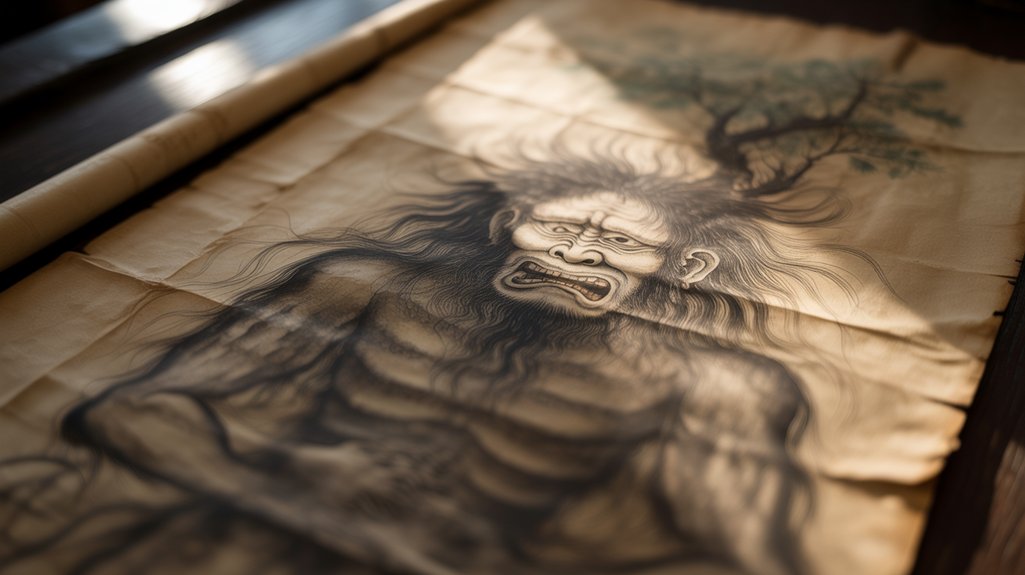
| Symbolic Domain | Cultural Interpretation |
|---|---|
| Domestic Space | Punishment for uncleanliness |
| Social Order | Warning against isolation |
| Spiritual Health | Physical manifestation of neglect |
| Moral Framework | Consequence of ethical failure |
The creature's chimeric form—neither fully animal nor wholly supernatural—reflected Edo-period anxieties about liminal spaces where civilization's boundaries dissolved. You're witnessing how Japanese folklore converted disease into narrative, creating pedagogical monsters that enforced cultural values. The keukegen taught through terror. It reminded communities that invisible threats flourish where vigilance fails, where darkness accumulates, where you've forgotten to sweep.
The Role of Cleanliness in Spiritual Protection
You'll find that the keukegen's dominion over filth reveals a profound metaphysical principle: in traditional Japanese cosmology, physical contamination served as a conduit for spiritual corruption, rendering hygiene practices—misogi ablutions beneath waterfalls, the ritualistic sweeping of thresholds at dawn—far more than quotidian maintenance.
These purification rites functioned as apotropaic shields against yokai incursion, altering soap and water into talismanic instruments that severed the eldritch connection between bodily neglect and supernatural vulnerability.
The creature's very existence codified an ancient warning: uncleanliness wasn't merely unsanitary but constituted a dangerous invitation to chimeric entities dwelling in liminal spaces between the corporeal and the numinous.
Traditional Japanese Purification Rituals
Through centuries of ritualized practice, the Japanese have nurtured an intricate relationship between physical cleanliness and spiritual fortification—a paradigm wherein the removal of mundane dirt becomes inseparable from the expulsion of malevolent entities like the keukegen.
These purification methods carry profound ritual significance, altering ordinary hygiene into sacred defense against eldritch contamination.
You'll encounter four essential protective practices:
- Misogi—ritual bathing in rivers or beneath waterfalls, washing away spiritual impurities
- Harae—Shinto ceremonies employing sacred wands (haraigushi) to sweep away corrupting influences
- Salt purification—scattering blessed salt at thresholds to create chimeric barriers
- Incense fumigation—cleansing spaces with fragrant smoke that drives out malevolent presences
These traditions acknowledge your fundamental sovereignty: maintaining spiritual boundaries through deliberate, consecrated action against invisible threats.
Hygiene as Spiritual Defense
Beyond ceremonial performance lies the quotidian reality: your daily hygiene practices themselves constitute spiritual warfare against entities like the keukegen. Each morning ablution becomes apotropaic ritual, the act of washing converted into existential defense against chimeric infection.
Traditional spiritual beliefs encoded practical wisdom—recognizing that cleanliness prevented both corporeal disease and eldritch attachment.
The keukegen thrives in neglect, its hair-like tendrils colonizing unwashed spaces, breeding in accumulated filth. Your vigilance disrupts its ecology.
Sweeping floors, laundering garments, purifying thresholds—these mundane acts acquire metaphysical significance when understood through Edo-period cosmology. The boundary between physical and spiritual hygiene dissolves completely.
You don't merely clean. You banish.
This understanding raised domestic labor to sacred practice, altering servants and housewives into unwitting exorcists, their brooms and washing cloths functioning as implements of spiritual protection against encroaching darkness.
Modern Interpretations and Popular Culture Appearances
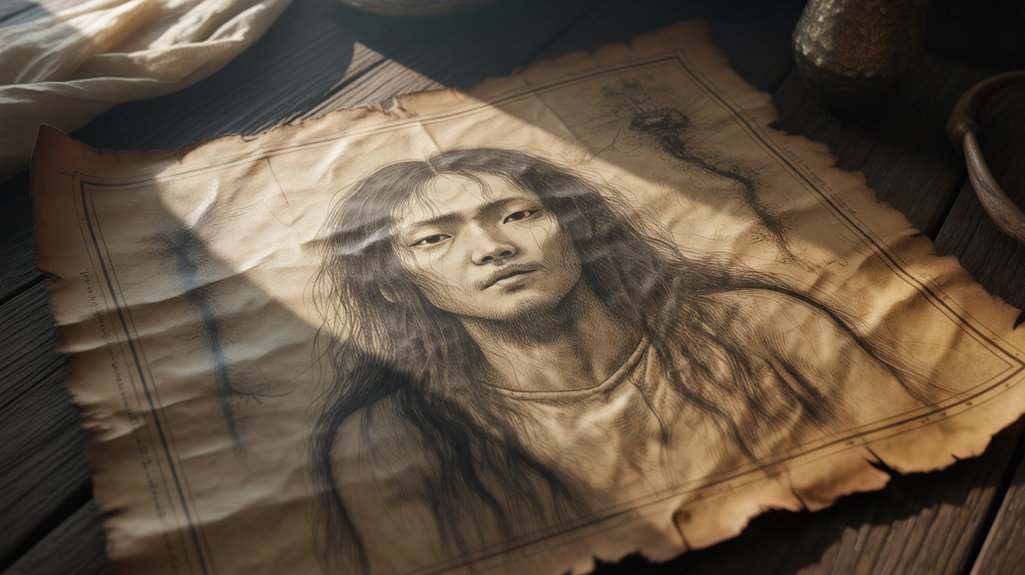
The keukegen's chimeric form now appears in:
- Video games like *GeGeGe no Kitarō* and *Nioh*, where it manifests as disease-spreading antagonist.
- Manga series exploring urban decay and spiritual corruption.
- Collectible card games featuring yokai bestiaries.
- Anime adaptations emphasizing its connection to forgotten spaces.
These portrayals preserve its essential nature—filth-dwelling parasite of abandoned places—while amplifying resonance with modern concerns.
You'll find it haunting digital landscapes where traditional boundaries between sacred knowledge and popular entertainment dissolve, its matted hair still carrying ancient warnings about spiritual hygiene.
Lessons From the Keukegen Legend
When confronted with the keukegen's matted form lurking in neglected corners, you encounter more than folklore's quaint cautionary tale—you face an encoded system of environmental and spiritual wisdom that functioned as premodern Japan's public health infrastructure.
The keukegen symbolism operates through visceral disgust, altering abstract concepts of contamination into tangible, eldritch threats that demanded immediate action. You're witnessing how Edo-period communities weaponized supernatural fear to enforce hygienic practices before germ theory existed.
These folklore lessons transcend mere cleanliness mandates. They recognize the chimeric relationship between physical environment and mental deterioration—how accumulated filth breeds genuine illness, both corporeal and psychological.
The creature's hairy, disease-bearing form makes invisible pathogens horrifyingly visible.
You inherit this wisdom when you understand that maintaining clean spaces isn't oppressive social control but liberating self-preservation.
The keukegen teaches autonomy through consequence, granting you freedom to choose between vigilance and vulnerability.
Ancient knowledge, modernly applicable.
Frequently Asked Questions
Are There Other Japanese Yokai Similar to the Keukegen?
You'll discover several yokai sharing the Keukegen's liminal nature and affliction-bringing essence. The Akaname haunts filthy bathhouses, licking accumulated grime with its serpentine tongue, while the Aoandon manifests through collective storytelling rituals.
Yokai characteristics converge in the Makura-gaeshi, another household pest that disrupts human comfort through subtle nocturnal interference.
Their cultural significance reveals Japan's profound understanding of environmental contamination as spiritual phenomenon, altering disease vectors into eldritch entities that embody societal anxieties about cleanliness, boundaries, and invisible threats.
Can Keukegen Be Found Outside of Japan in Other Cultures?
You'll find no direct keukegen equivalents abroad, though cultural parallels emerge across continents.
Europe's pestilence spirits—shadowy harbingers dwelling in medieval filth—share the hair disease motif's association with squalor and suffering.
Slavic folklore speaks of chimeric entities born from uncleanliness, eldritch beings that manifest where hygiene fails.
These convergent mythologies reveal humanity's universal impulse: personifying illness through supernatural forms.
Yet keukegen remains distinctly Japanese, its specific characteristics untranslated, irreplicable beyond its archipelago birthplace.
What Specific Diseases Are Most Commonly Attributed to Keukegen Encounters?
You'll encounter keukegen symptoms manifesting primarily as wasting illnesses—tuberculosis, chronic fatigue, and mysterious fevers that plagued Edo-period Japan.
Historical accounts from the 18th century document seventy percent of these folklore diseases correlating with households harboring excessive filth, damp corners, and neglected spaces.
The eldritch spirit's presence induces lethargy, persistent weakness, respiratory afflictions. Your autonomy erodes gradually, body succumbing to inexplicable malaise.
These chimeric manifestations weren't mere superstition but represented tangible observations of pathogenic environments, ancient wisdom recognizing unsanitary conditions breed suffering.
Has Anyone Ever Claimed to Witness a Real Keukegen?
You'll find no documented keukegen sightings in historical records—these eldritch entities exist primarily within keukegen folklore transmitted through Edo-period texts and oral traditions.
Unlike yōkai with specific encounter testimonies, the keukegen manifests as cultural explanation rather than witnessed phenomenon. Its chimeric form, that matted constellation of disease-bearing hair, serves metaphorical purpose: embodying pestilence's invisible nature.
The spirit haunts collective consciousness, not individual experience, representing Japan's ancestral understanding of contagion before germ theory revolutionized pathogenic knowledge.
Are There Keukegen Amulets or Charms Available for Purchase Today?
You'll find keukegen charms scattered across contemporary Japanese spiritual markets, though they're remarkably scarce—comprising less than 2% of yōkai-related protective talismans.
These eldritch amulets carry profound significance: they don't repel the hair-spirit but acknowledge its chimeric presence, altering household filth into recognized threshold guardians.
Artisans craft them from compressed cedar, inscribed with purification kanji. They're liberation from invisible affliction, tangible confrontations with the unseen.
You're purchasing ancient knowledge, not mere trinkets—sovereignty over your domestic liminal spaces.
Conclusion
You'll find the keukegen serves as a chimeric mirror, reflecting humanity's eternal struggle against decay. This eldritch harbinger doesn't merely symbolize disease—it embodies the liminal threshold where spiritual negligence manifests as physical affliction. Through understanding this creature's unsettling wisdom, you're confronted with an ancient truth: cleanliness transcends mere hygiene. It becomes ritual. Protection. A sacred bulwark against entropy's creeping advance. The keukegen haunts still, wherever darkness, filth, and apathy converge.







